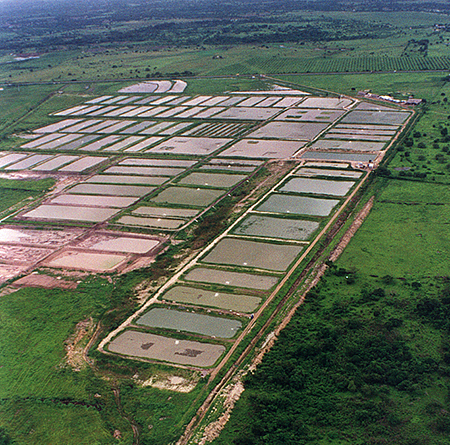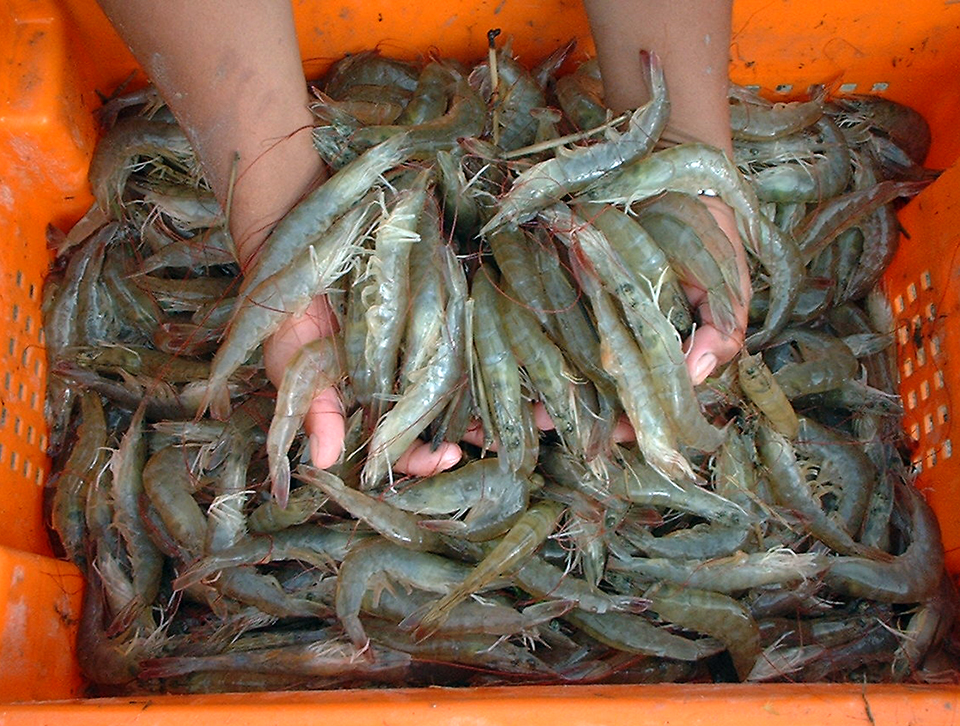The Inacua experience

Inland shrimp farming in Ecuador started in mid-2000, when traditional shrimp-farming productions were at their lowest point due to the White Spot Syndrome Virus (WSSV). The main reasons to produce shrimp inland were to utilize underground water sources and exclude WSSV carriers. Ideal preexistent infrastructure and producing conditions were present due to the red claw (Cherax quadricarinatus) boom that took place in the mid-1990s.
Inland farms in Ecuador
Since then, 60 inland shrimp-farming projects have developed – some with great success (production of 5,896 kilograms per hectare per cycle), while others had discouraging results (about 7 kilograms per hectare per cycle). Some inland operations have already introduced WSSV into their systems through contaminated stock, by adding contaminated brine, or by simply having inadequate biosecurity protocols.
Inacua farm
Inacua, one of several former red claw farms in Ecuador, currently produces (Penaeus vannamei) inland. The farm has 60 earthen ponds that range 0.2 to 0.4 ha in size, for a total of 15.3 ha of ponds. Water is supplied by one 135-meter-deep well that produces 2.08 cubic meters per minute in the dry season and 2.27 cubic meters per minute in the rainy season. After passing through a degassing tower to separate unwanted mineral components, pumped water goes into a 0.5-ha reservoir. This reservoir is quite deep (3.4-4 m), to prevent the establishment of fouling benthic algae.
Inacua’s grow-out ponds, as well as nursing ponds, use approximately 24 horsepower per hectare of aeration. Trials made with aeration at 12, 18, and 24 hp indicated the latter was the most cost-efficient setup for the relatively high densities stocked. Airlift pumps have also been installed for circulation and destratification of pond water.
Seedstock acclimation and stocking

Shrimp postlarvae (PL) are acclimated down to 5 ppt at the hatchery and transported in tanks when they reach PL18-22. Since pond salinity ranges 0.9 to 1.2 ppt, the postlarvae are further acclimated in 2.7-ton raceways at the farm for 48 hours, using water from the nursery ponds where they are going to be stocked. Extreme care is taken during this period, and several live, fresh, frozen and dry feeds are used. Ammonia levels should be carefully monitored, carbonaceous materials and Bacillus sp. bacteria should be added to aid decomposition of organic matter. Supplemental nutrition is also important.
One day prior to stocking the animals in the nursery ponds, 35 percent protein feed is added to the raceways to make sure the postlarvae have soft pellets and benthic microbes to feed on when they are stocked. Also, a small-eye seine net is run lengthwise through the whole pond to trap opportunistic insects such as dragonfly larvae, backswimmers, water beetles, or water boatmen, which might feed on the shrimp larvae. Once this process is finished, artificial substrate can be installed in the ponds and the animals stocked. Survival rates average ofver 75 percent in most nursery ponds.
Juvenile transfer
After spending several weeks in the nursery ponds, juvenile shrimp are transferred to grow-out ponds and stocked at densities ranging 75 to 120 animals per square meter. Animals are fed 35 percent-protein premium feed until they reach 3 to 4 grams, when the feed protein level is reduced to 28 percent. When the animals reach 7 to 8 grams, the protein is further reduced to 17 percent until harvest.
Water and soil quality
Diatoms are the algae of choice, along with some chlorophytes and a few cyanophytes. Parameters are exhaustively monitored on a daily basis (oxygen, trubidity, pH, conductivity, ionic balances, algal quality and quantity, zooplankton, soil quantity, etc.). Bacterial amendments and carbonaceous materials are used regularly to maintain good soil quality. Due to the high nutrients in farm soils and the intense equatorial sunlight, bacterial flocs have not been able to completely dominate pond environments, unless the ponds are completely lined or large amounts of carbon used, which would be cost prohibitive.
Addition of minerals
Due to the severe rains Ecuador experiences, particularly during El Niño events, water flow into the underground strata increases dramatically, lowering most mineral components in well water. Minerals are added to the ponds weekly in order to maintain an adequate ionic balance to assure normal shrimp development.
Production
The average production cycle is 100 days, with a mean weight at harvest of 11.5 grams. Production has ranged 4,989 to 5,896 kilograms per hectare. Grow-out survival rates have varied from 24 percent to 60 percent. In one instance, a power failure caused the aerators to malfunction in a pond, with the loss of about 450 kg of shrimp in one night.
In the current cycle, shrimp in most ponds have averaged weekly growth over 1.3 grams. Shrimp that have been in ponds for 11 weeks have reached 13.75 grams (1.25 grams per week). These growth rates are attributed to the prevailing high temperature (over 29.2 degrees-C) and the lower than normal salinity (0.7 to 1.0 ppt) due to the heavy rainfall that is common from January to April. The results for the rainy season seem to show better growth due to 24 hour per day aeration per circulation per destratificaton, high temperatures and lower salinities. When we first began, we had problems with mortalities caused by propeller aspirator aerators. he result was reduced density and increased growth of surviving animals, which began to increase significantly during the sixth week.
Harvesting
Ponds are drained to about half their depth for harvesting. The harvest team catches shrimp in a seine moved from the shallow to the deep end of the pond, which confines all the shrimp to the drainage sump. The animals are taken out alive in crates to assure 100 percent head-on prices, which, ironically, are now at a record low.
Water treatment and reuse
Since current Ecuadorian environmental laws prohibit any inland aquaculture project from releasing pond effluents, all water is reused at the farm. There is no water exchange during the shrimp production cycle. Water is drained from the ponds only for harvesting.
Effluents are collected in a battery of three sedimentation ponds, where the water remains in each one for several days. These sedimentation ponds have been stocked with several varieties of emergent plants that help filter out suspended solids before the water goes into other treatment ponds. The second and third sedimentation ponds contain water hyacinths (Eichhornia crassipes), which absorb some of the nutrients in the water before it is pumped back into the ponds.
Other water uses
Some of this nutritionally rich residual water is also used for irrigating rice, corn, bamboo and teak wood. In the near future, Inacua will evaluate hydroponics to improve its integration of aquaculture and agriculture.
(Editor’s Note: This article was originally published in the June 2002 print edition of the Global Aquaculture Advocate.)
Now that you've finished reading the article ...
… we hope you’ll consider supporting our mission to document the evolution of the global aquaculture industry and share our vast network of contributors’ expansive knowledge every week.
By becoming a Global Seafood Alliance member, you’re ensuring that all of the pre-competitive work we do through member benefits, resources and events can continue. Individual membership costs just $50 a year. GSA individual and corporate members receive complimentary access to a series of GOAL virtual events beginning in April. Join now.
Not a GSA member? Join us.
Authors
-
Marcelo J. Salame
Bioexportables
Inacua Crustacean Farming
Cdla. Kennedy Norte, Mz. 404 Solar 22
Guayaquil, Ecuador[116,101,110,46,116,101,110,111,99,108,101,116,64,101,109,97,108,97,115,97,109]
-
Andres E. Salame
Bioexportables
Inacua Crustacean Farming
Cdla. Kennedy Norte, Mz. 404 Solar 22
Guayaquil, Ecuador
Tagged With
Related Posts

Health & Welfare
Challenging Pacific white postlarvae with AHPND
Study results indicate that P. vannamei challenged with AHPND in biofloc had higher survival rates than shrimp challenged in clear water.

Aquafeeds
Considerations for automatic feeding in shrimp ponds
Automatic feeding is becoming important for lowering production costs through better shrimp growth, lower feed conversion rate and higher survival rate.

Intelligence
Can India sustain its farmed shrimp boom?
Long a global leader in farmed fish production, India has transitioned into an aquaculture powerhouse. Can its expanding shrimp sector keep the rapid pace?

Health & Welfare
Ecuador develops GIS-assisted alert system for shrimp farming
Geographic information systems provide analysis of spatial and temporal datasets in a cartographic form and allow database query and modeling at the same time.


